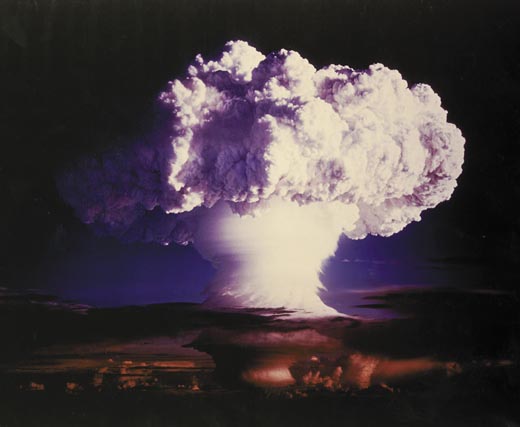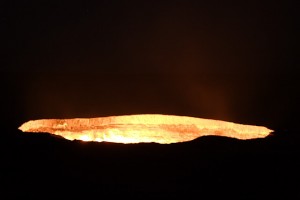5km across, the fireball erupted from the island of Elugelab and engulfed the sky. The shock wave vaporised everything within 5km, and scraped the neighbouring islands clean, no buildings or plants remained. 2 hours later some helicopters flew over what used to be Elugelab. The island was gone. In its place was a dark blue welt in the ocean, 2km across, and deep enough to hold a 17 story building. The island had been vaporised. It was 1952, and the largest bomb in the world had just been detonated.
The United States made the bomb because it was afraid. In late 1949 the Soviet Union had created and detonated ‘First Lightning’ – a nuclear bomb just like those dropped at the end of World War II. The United States was no longer the only nuclear superpower. Tensions escalated, and they needed something new. They were going to need a bigger bomb.
In January 1950, President Truman announced that the United States would develop a new bomb, superior to the A-bomb. A hydrogen bomb that would push the United States into the Thermonuclear era. Unfortunately nobody knew how to make the H-bomb.
H-bombs are thermonuclear, meaning nuclear fusion. They make heat in the same way the sun, and billions of others stars make their energy. Two small atoms like hydrogen hit each other and combine to make a larger atom, at the same time they release large amounts of energy. The problem is that fusion needs immense heat and pressure. That difficulty is why it was happening easily in the sun, but not so much on Earth.
In 1951 Stanislaw Ulam and Edward Teller overcame that barrier. With their combined ideas, thermonuclear bombs were possible – in theory. To test the theory, they needed an experiment. Project Ivy was started, and it was the perfect opportunity to test.
The Building Bomb
Project Ivy was aimed at improving U.S. nuclear weapons in two ways. The first was the H-bomb, the other was making a larger, A-bomb. The H-bomb was Ivy Mike, at its construction it was the largest, heaviest and most powerful bomb in existence. I say bomb, it was closer to a factory-sized nuclear fridge.
Mike was not a bomb ready to be dropped from a plane, it was designed purely as an experiment, so it looked like an aircraft hangar or factory. It was assembled in the Pacific proving grounds, on Elugelab, a small island on Enewetak atoll. The main bomb assembly was over 6 metres tall and 2 metres wide. Covered in metal case 30cm thick, it was very large, shiny and cold. They nicknamed it “Sausage.” Sausage weighed a dainty 56 metric tonnes.
The idea behind the Teller-Ulam design was to put a bomb on top of the bomb. The first bomb was a traditional nuclear weapon power, this would blow up and for a very small amount of time be held in by the casing. The heat and force of it would head downwards and hit the store of hydrogen beneath. If the force was enough, fusion would begin and the H-bomb would be born with a death-laced burst of fire.
To keep everything nice and cool, 18 tonnes of cryogenic cooling were attached to Sausage. This was to stop the liquid deuterium (a type of hydrogen) evaporating. All in all, Ivy Mike weighed 74 metric tonnes. In October they were ready, but they needed conditions to be right. There were up to 20,000 people at risk on distant islands, and they also wanted to be able to collect samples from the mushroom cloud.1st November, 1952, the weather was in their favour. Just before dawn the ships assembled to watch, 48km away, just beneath the horizon.
Just before detonation four F-84G fighter jets were launched towards Elugelab, ready for work. At 7.15am the countdown began. Everyone on the ship decks put on protective goggles or turned their backs. Then Ivy Mike broke the world.
Amongst The Boiling Clouds

It had the strength of 11 megatons, the strength of millions of tons of TNT. The Thermonuclear age had come to the world, announced with the largest fireball yet made by humans. Radioactive coral rained down like nuclear confetti on the ships, having covered all that distance.
Above, the mushroom cloud grew hungrily, pushing up 33km in 2 minutes and eventually spreading out to cover 7,500 square kilometres of sky. What had happened? The four jets would find out. Each was equipped with radioactive sampling boxes on their wing tips, they would scoop up any particles and then they would be sent back to the U.S. for testing. They were going to fly into the mushroom cloud.
They arrived 90 minutes after detonation, dwarfed by the colossal stem of cloud 32km across. The umbrella of the mushroom loomed over them, beyond the reach of their engines and fuel. The stem beckoned, and the first 2 jets dove in, specks among the maelstrom. Bathed in nuclear radiation they hit their limits 5 minutes in, and turned 90 degrees to exit the cloud. They both successfully burst into light, and were bathed in the Sun’s own thermonuclear glow.
The remaining 2 jets plunged in, and misfortune struck. One jet stalled during a turn and plummeted for 6km down the boiling shaft. The pilot managed to regain control and exit, but couldn’t find either the fuel tanker or another craft. Eventually he located the radio beacon for Enewetak and headed for it. The island was in sight but the jet caught fire mid-air and he ran out of fuel. The jet went down over the water, and the pilot couldn’t escape, his lead-lined vest made movement too difficult. Later searches couldn’t find the sunken plane or the body of its pilot, Captain Jimmy Robinson.
Boy Fallout
The shock wave from Ivy Mike was conducted through Earth and picked up back in the U.S. by some seismometers. Edward Teller, co-creator of the bomb was one of the first to know. Back in America it was Halloween, but he had an extra reason to celebrate. Overjoyed, he sent a telegram to his colleagues. For security reasons it said only: “It’s a boy.”
As for Elugelab, it had been entirely vaporised, it doesn’t appear in modern Atlases. Over the next 30 years the U.S. put hundreds of millions of dollars into decontaminating the atoll. In 1980 the announced areas safe to live in, and residents moved back the same year. Ready to live their lives in their own space.
News of Ivy Mike was leaked within hours of detonation and were widely reported, but the government kept very tight-lipped over the entire thing. It was presidential election season after all, and they had been ordered to mention nothing at all. Admittance finally came in 1954, by which time the Soviet Union had independently created its own H-bomb ‘Sloika.’ Sloika, as well as being named after a layered puff-pastry, could be carried and dropped from planes. The nuclear game had changed once more, the U.S. was on the back foot again. The nuclear situation would remain unstable over the next few decades, but never again would a clear leader exist. At least until the Soviet Union itself began to decay.
Something Old, Something New
Ivy Mike was a success in many ways. It proved the concepts, if not designs for the world of thermonuclear weaponry. Nuclear power is all around us though, ever-present. Every star in the sky is a thermonuclear powerhouse, giving light, heat, and life to their faithfully orbiting spheres. Nuclear fission provides 90% in the earth’s core, keeping the continents moving and volcanoes erupting. Not everything was catching up with nature though, from the ash came new forms.
The 3 surviving jets brought back radioactive particles, when analysed they revealed two surprises. Elements, not found anywhere on Earth, had been created in the fiery heart of Mike. Einsteinium and Fermium, synthetic elements only found as the results of experiments, decaying slowly with time. They were the first synthetic elements ever created, later nuclear tests would reveal more unexplored elements.
Vaporizing an entire island was also quite impressive.
All images public domain, courtesy of the US Department of Energy.
Further Reading and Viewing:
- Short Film on Ivy Mike by the U.S. Military
- Cartage: Ivy Mike Design Details
- Nuclear Weapons Archive: Ivy Mike
- Nuclear Secrecy: Ivy Mike Secrecy and Leaks
- Smithsonian: Radioactive Sampling
- Wikipedia: Teller-Ulam Thermonuclear Designs
- Wikipedia: Soviet Atomic Bomb Project
- PhysOrg: Heat in Earth’s Core


